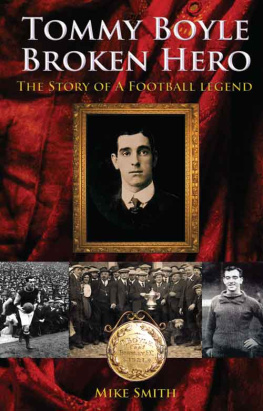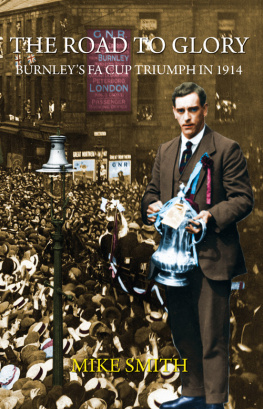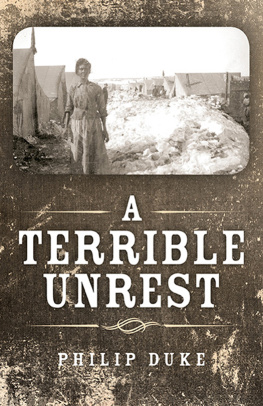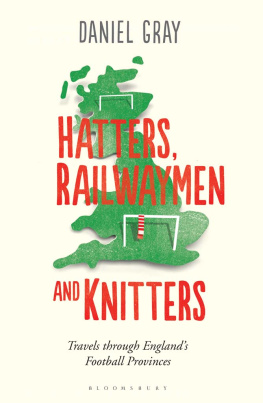
www.grosvenorhousepublishing.co.uk
Introduction
In September 1911, Thomas William Boyle walked through the doors of Burnley Football Club and a legend was born. Boyle was one of the most outstanding players of his generation, one of the best centre-halves who ever stepped onto a football field a gem amongst jewels, was one football managers assessment of him. He represented England at international level and in 1914 became the first captain to be presented with the FA Cup by the reigning monarch, His Majesty, King George V. The Yorkshireman won all of footballs major honours, but once his playing days were over, something inside Tommy Boyle broke.
On leaving school at twelve, the young Tommy Boyle became a miner and his first sporting interest was in athletics where he competed as a sprinter, but it was football where he made his mark. Despite his stature at five-feet seven, his ability as an attacking right-half was spotted by the Barnsley manager Arthur Fairclough, who signed him to professional terms in 1906. Boyle went on to lead Barnsley to their first Cup final in 1910 and was later sold to Burnley. It was at Turf Moor where he made his biggest contribution to the game. Boyle led The Clarets to promotion to Division One, he represented England at full international level and won the FA Cup. When the First World War came he became Bombardier Boyle serving in the Royal Artillery on the Western Front. It was there he was badly wounded and for a while it looked like his playing career was finished. But being the gritty character he was, Tommy Boyle defied the consultants and fought his way back to play again. He crowned his comeback by winning the League championship in style, leading a Burnley side that stayed undefeated for thirty League matches, a record the club held until the Arsenal side of Dennis Bergkamp and Thierry Henry surpassed it in 2004.
There was no mistaking Boyle on the football field. With his jersey tucked in and his shorts pulled up nearly under his armpits, he would make the most noise, barking his instructions to his teammates. A real captain if ever there was one, said Charles Buchan about Boyle in 1932. He dominated games with sheer enthusiasm, determination and thrived on conflict. Yet despite all of his successes in the game and the enjoyment he brought to thousands, when his playing days were over Tommy Boyle struggled to come to terms with a life without football.
Broken Hero turns the clock back to the beginning of the twentieth century, revealing the events and people who played the game with Boyle at the time. By the early 1900s, football had changed. With the introduction of the Football League and win bonuses equal to a working mans weekly wage, the former gentlemans game was consigned to history. There was nothing gentlemanly in some of the brutal challenges meted out on Saturday afternoons in games that might also feature a punch-up or the continuation of an ongoing vendetta between players. And more often than not, in the thick of it all was Tommy Boyle, who gave as good as he got, all five foot seven of him.
September 2011 sees the 100th anniversary of Tommy Boyles arrival at Burnley Football Club. Broken Hero covers Boyles formative years; his background, what influenced him and the period of the First World War which devastated the team he played in. Finally the story looks at how after such an illustrious career, Tommy Boyle ended up with nothing, spending the last years of his life in a mental hospital. Drawing on material not previously published, Tommy Boyle - Broken Hero tells the remarkable story of a real football hero who in his prime had character, presence and generosity in abundance, but who in later life became a dangerous man, to himself and others.
Mike Smith
Summer 2011
Acknowledgements
A number of people deserve thanks for helping me put together the pieces of the Tommy Boyle jigsaw. Thanks go to David Wood, Arthur Bower and Grenville Firth of Barnsley Football Club who provided information about Tommys time there; David Coefield at St. Helens Church in Hoyland and Geraint Parry and Peter Jones who provided me with details of Tommys season at Wrexham FC. Id like to thank Rob Cavallini, Ulrich Matheja, Jan Buschbom and Olaf Sievers for information on Tommys year working in Germany.
In Burnley, thanks go to local historians Roger Frost, Andrew Gill and Mike Townend at Towneley Hall and to Ken Ashton who manages the Asylum website. Thanks to Roger and Sue Haydock for information from the Lancashire Football Association and to Paul Evans at Firepower, The Royal Artillery Museum in Woolwich. Thanks go to Tony Scholes, editor of ClaretsMad, the online website dedicated to Burnley supporters across the globe and to Charlie Wilson who helped me knock the story into shape. Thanks also to Derek Crossland for his advice and to Phil Drinkwater who helped me find the first piece of the Tommy Boyle jigsaw. Many thanks go to Ray Simpson at Burnley Football Club and to the living descendents of the Boyle family who live all over the world: Eileen Varey, John Jarvis, Maureen Sykes, Kevan Boyle and Sonia St. John, for their photographs and stories of Uncle Tommy.
Nearly finished, but they do deserve a special thanks: Burnley Central Library staff put up with me for nearly three years and provided an endless supply of books and documents from libraries all over the country. Thank you for the fantastic service you provide. If I have missed anyone, my sincerest apologies and I really do thank you for your help and support.
Finally, a special thanks go to my family for putting up with what became an obsession and to apologise for all the lost weekends spent in archives, museums and libraries all over the UK living and breathing old football stuff.
About the Author
Mike Smith was born and brought up in Whittlefield in Burnley and one of his earliest recollections was as a five-year-old seeing the Burnley team touring the town in an open-top coach having won the 1960 League Championship. He has supported Burnley Football Club ever since and still lives in the area. Mike has a passion for sport history and has enjoyed an extensive career working in the engineering industry, teaching in further and higher education and he currently works at The University of Manchester and teaches for the Open University. Broken Hero is his first published work.
Disclaimer
The events that took place throughout this story were real. The people named in the story were real and the historical dates, events and facts found from official documents and source material provided in the story are all true. However, in drawing the facts together from over a century ago, the book cannot claim to be a totally accurate biographical account. Some elements of the latter part of the story can only be said to be what the author believes to have happened to the central character based on anecdotal evidence. As such the book makes no claim to be complete in every sense and aims to both inform and entertain.
For Julia, Clare, Dorothy and Norman.
List of Figures
Fig 1:Primrose Bank Infirmary, Burnley
Fig 2:Platts Common 1893
Fig 3:Platts Common street scene 1905
Fig 4:Hoyland Silkstone Colliery, Platts Common
Fig 5:Barnsley FC Crest
Fig 6:Barnsley FC team 1906-07
Fig 7:Barnsley FA Cup Team 1907
Fig 8:The Crystal Palace, Sydenham
Fig 9:Barnsley v Queens Park Rangers FA Cup Quarter Final 1910
Fig 10:Tommy tosses up at the 1910 Semi-final vs Everton at Old Trafford
Fig 11:Barnsley score in the FA Cup Semi-final
Next page









